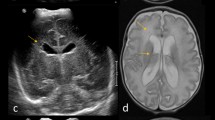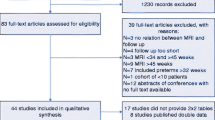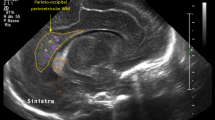Abstract
Introduction
Preterm births are increasing in number and while the rates of cerebral palsy have declined, there are increasing numbers of infants who survive with handicaps. In some studies, up to 50 % of children will have morbidity when followed up to school age.
Methods
A review of current literature was conducted to determine the validity of routine cranial ultrasound scans (CUS) to predict neurodevelopmental outcomes, including motor and cognitive deficits. We also reviewed the additional benefit offered by including MRI scans in scanning protocols to enhance the reliability in predicting the neurodevelopmental sequelae of prematurity.
Results
CUS is valuable as a screening tool to determine significant brain injury when conducted regularly over the first weeks of life in preterm infants. Subtle changes on CUS are difficult to interpret and more precise information is offered by performing MRI scans. These are most often carried out at term equivalent age but earlier scans may be just as useful in predicting neurocognitive outcomes. When MRI scans are either normal or seriously abnormal, there is a very clear correlation with outcome to 2 years of age. Mild and moderate degrees of injury defined on MRI need more sophisticated scanning sequences to determine the likelihood of associated sequelae. Follow-up to school age is essential to diagnose more subtle cognitive delays.
Conclusion
CUS provides a good screening tool to detect serious brain injury resulting in motor handicaps but MRI scans are complementary and necessary to accurately predict the outcomes of preterm infants, especially cognitive delays.








Similar content being viewed by others
References
Ancel PY, Livinec F, Larroque B, Marret S, Arnaud C, Pierrat V, Dehan M, N'Guyen S, Escande B, Burguet A, Thiriez G, Picaud JC, André M, Bréart G, Kaminski M, EPIPAGE Study Group (2006) Cerebral palsy among very preterm children in relation to gestational age and neonatal ultrasound abnormalities: the EPIPAGE cohort study. Pediatrics 117:828–835
Cornette LG, Tanner SF, Ramenghi LA, Miall LS, Childs AM, Arthur RJ, Martinez D, Levene MI (2002) Magnetic resonance imaging of the infant brain: anatomical chacteristics and clinical significance of punctuate lesions. Arch Dis Child Fetal Neonatal Ed 86:F171–F177
De Vries LS, Radenmaker KJ, Groenendaal F, Eken P (1999) Assymetric myelination of the posterior limb of the internal capsule in infants with periventricular hemorrhagic infarction: an early predictor of hemiplegia. Neuropediatrics 30:314–319
De Vries LS, Van Hastert IL, Rademaker KJ, Koopman C, Groenendaal F (2004) Ultrasound abnormalities preceding cerebral palsy in high-risk preterm infants. J Pediatr 144:815–820
De Vries LS, Van Haastert IC, Benders MJ, Groenendaal F (2011) Myth: cerebral palsy cannot be predicted by neonatal brain imaging. Semin Fetal Neonatal Med 16:279–287
Dyet LE, Kennea N, Cell SJ, Maaloof E, Ajayi-Obi M, Duggan P, Harrisson M, Allsop J, Hajnal J, Herlihy A, Edwards B, Laroche S, Cowan F, Rutherford F, Edwards D (2006) Natural history of brain lesions in extremely preterm infants studies with serial magnetic resonance imaging from birth and neurodevelopmental assessment. Pediatrics 118:536–548
Hack M, Costello DW (2008) Trends in the rates of cerebral palsy associated with neonatal intensive care of preterm children. Clin Obstet Gynecol 51(4):763–774. doi:10.1097/GRF.0b013e3181870922.Review
Hintz SR, Kendrick DE, Vohr BR, Poole WK, Higgins RD (2005) Changes in neurodevelopmental outcomes at 18–24 months corrected age among infants of less than 25 weeks gestational age born in 1993–1995. Pediatrics 115:1645–1651
Hintz S, O'Shea M (2007) Neuroimaging and Neurodevelopmental outcomes in preterm infants. Semin Perinatol 32:11–19
Kidokoro H, Neil JJ, Inder T (2013) New MR imaging assessment tool to define brain abnormalities in very preterm infants at birth. AJNR. doi:10.3174/ajnr.A3521
Kuban KC, Allred EN, O’Shea TM, Paneth N, Pagano M, Dammann O, Leviton A, Du Plessis A, Westra SJ, Miller CR, Bassan H, Krishnamoorthy K, Junewick J, Olomu N, Romano E, Seibert J, Engelke S, Karna P, Batton D, O'Connor SE, Keller CE, ELGAN study investigators (2009) Cranial ultrasound lesions in the NICU predict cerebral palsy at age 2 years in children born at extremely low gestational age. J Child Neurol 24:63–72
Limperopoulos C, Bassan H, Gauvreau K, Robertson RL Jr, Sullivan NR, Benson CB, Avery L, Stewart J, Soul JS, Ringer SA, Volpe JJ, duPlessis AJ (2007) Does cerebellar injury in premature infants contribute to the high prevalence of long term cognitive, learning and behavioral disability in survivors? Pediatrics 120:584–593
Maitre NL, Marshall DD, Price WA, Slaughter JC, O'Shea TM, Maxfield C, Goldstein RF (2009) Neurodevelopmental outcome of infants with unilateral or bilateral periventricular hemorrhagic infarction. Pediatrics 124:e1153–e1160
Mathur AM, Neil JJ, Inder TE (2010) Understanding brain injury and neurodevelopmental disabilities in the preterm infant: the evolving role of advanced magnetic resonance imaging. Semin Perinatol 34:57–66
Myers E, Ment LR (2009) Long-term outcome of preterm infants and the role of neuroimaging. Clin Perinatol 36(4):773–789. doi:10.1016/j.clp.2009.07.008. Review, vi
Miller SP, Ferreiro DM, Leonard C, Piecuch R, Glidden DV, Partridge JC, Perez M, Mukherjee P, Vigneron DB, Barkovich AJ (2005) Early brain injury in premature newborns detected with magnetic resonance imaging is associated with adverse early neurodevelopmental outcome. J Pediatr 147:609–616
Patra K, Wilson–Costello D, Taylor HG, Mecuri–Minich N, Hack M (2006) Grade I-II intraventricular hemorrhage in extremely low birth weight infants: effects on neurodevelopment. J Pediatr 149:169–173
Pinto-Martin JA, Riolo S, Cnaan A, Holtzman C, Susser MW, Paneth N (2005) Cranial ultrasound prediction of disabling and non disabling cerebral palsy at age two in a low birth weight population. Pediatrics 95:249–254
Resch B, Jammernegg A, Perl E, Riccabona M, Maurer U, Müller WD (2006) Correlation of grading and duration of periventricular echodensities with neurodevelopmental outcome in preterm infants. Pediatr Radiol 36(8):810–815, Epub 2006
Rutherford MA, Supramanian V, Ederies A, Chew A, Bassi L, Groppo M, Anjari M, Counsell S, Ramenghi LA (2010) Magnetic resonance imaging of white matter diseases of prematurity. Neuroradiology 52:505–521
Sherlock RL, Anderson PJ, Doyle LW (2005) Neurodevelopmental sequelae of intraventricular hemorrhage at 8 years of age in a regional cohort of ELBW/very preterm infants. Early Hum Dev 81:909–916
Sie L, Hart A, van Hof J, de Groot L, Lems W, Lafeber H, Valk J, Knaap V (2005) Predictive value of neonatal MRI with respect to late MRI findings and clinical outcome. A study in infants with periventricular densities on neonatal ultrasound. Neuropediatrics 36:78–89
Srinivasan L, Dutta R, Counsell SJ, Allsop JM, Boardman JP, Rutherford MA, Edwards AD (2007) Quantification of deep gray matter in preterm infants at term-equivalent age using manual volumetry of 3-tesla magnetic resonance images. Pediatrics 119:759–765
Tam EW, Rosenbluth G, Rogers EE, Ferriero DM, Glidden D, Goldstein RB, Glass HC, Piecuch RE, Barkovich AJ (2011) Cerebellar hemorrhage on magnetic resonance imaging in preterm newborns associated with abnormal neurologic outcome. J Pediatr 158(2):245–250. doi:10.1016/j.jpeds.2010.07.049, Epub 2010 Sep 15
van Haastert IC, Groenendaal F, Uiterwaal CS, Termote JU, van der Heide-Jalving M, Eijsermans MJ, Gorter JW, Helders PJ, Jongmans MJ, de Vries LS (2011) Decreasing incidence and severity of cerebral palsy in prematurely born children. J Pediatr 159(1):86–91.e1. doi:10.1016/j.jpeds.2010.12.053, Epub 2011 Mar 2
van Wezel-Meijler G (2011) Ultrasound detection of white matter injury in very preterm neonates: practical implications. Dev Med Child Neurol 53(suppl4):29–34
Whitaker AH, Feldman JF, Van Rossem R, Whitaker AH, Feldman JF, Van Rossem R, Schonfeld IS, Pinto-Martin JA, Torre C, Blumenthal SR, Paneth NS (1996) Neonatal cranial ultrasound abnormalities in low birthweight infants: relation to cognitive outcomes at six years of age. Pediatrics 98:719–729
Woodward LJ, Anderson PJ, Austin NC, Howard K, Inder TE (2006) Neonatal MRI to predict neurodevelopmental outcomes in preterm infants. N Eng J Med 355:685–694
Woodward LJ, Clark CA, Pritchard VE, Anderson PJ, Inder TE (2011) Neonatal white matter abnormalities predict global executive function impairment in children born very preterm. Dev Neuropsychol 36(1):22–41. doi:10.1080/87565641.2011.540530
Acknowledgments
We thank Dr Charles Raybaud, Dr. Margot Taylor, PhD, and Dr Steven Miller for their guidance in writing and reviewing the manuscript.
Conflict of interest
We declare that we have no conflict of interest.
Author information
Authors and Affiliations
Corresponding author
Additional information
This article is part of the special supplement “The Premature Brain”—Guest Editor: Charles Raybaud
Rights and permissions
About this article
Cite this article
Whyte, H.E.A., Blaser, S. Limitations of routine neuroimaging in predicting outcomes of preterm infants. Neuroradiology 55 (Suppl 2), 3–11 (2013). https://doi.org/10.1007/s00234-013-1238-6
Received:
Accepted:
Published:
Issue Date:
DOI: https://doi.org/10.1007/s00234-013-1238-6




